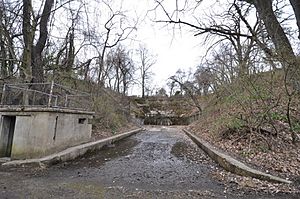Fort Howard (Maryland) facts for kids
Fort Howard was an important military base in Maryland, USA. It was built on the North Point peninsula. This location was perfect because it overlooked the main channel of the Patapsco River. This river leads directly into the harbor of Baltimore, Maryland.
The fort was named in 1902 after Colonel John Eager Howard. He was a hero from the American Revolutionary War. Fort Howard earned the nickname "Bulldog at Baltimore's Gate." It served as the main base for coastal defense guns protecting Baltimore. The fort is historically important for its connections to the War of 1812, the Spanish–American War, and World War II.
Today, the fort's land is split into two parts. One part is a public park where you can see the old gun batteries. The other part used to be a hospital for veterans. This area is now being redeveloped.
Contents
Where is Fort Howard?
Fort Howard is located in a community also called Fort Howard, Maryland. It sits in a very smart spot. It overlooks the entrance to the Patapsco River from the Chesapeake Bay. The North Point peninsula, where the fort is, is surrounded by water on three sides. Back River is to the east, Old Roads Bay to the west, and the Patapsco River to the south.
Fort Howard's History
The War of 1812 Connection
The area known as North Point was important even before Fort Howard was built. In 1814, during the War of 1812, British forces landed here. About 4,500 British soldiers came ashore on September 12, 1814. Their goal was to capture and burn Baltimore. This invasion was one of the largest in United States history.
The British plan was to march to Baltimore while their navy attacked Fort McHenry. But their advance was stopped. The British commander, Major-General Robert Ross, was killed by an American sharpshooter. This greatly lowered the spirits of the British troops.
American soldiers, led by Brig. Gen. John Stricker, fought bravely in the Battle of North Point. This battle took place southeast of Baltimore. After several hours, the Americans fell back. But they retreated in an organized way to strong defenses. These defenses had about 100 cannons and 20,000 volunteer soldiers.
The British, now led by Col. Arthur Brooke, saw how strong the American defenses were. They waited for their fleet to help them attack Fort McHenry. But after two days of fighting and a big rainstorm, the British gave up. They went back to North Point and boarded their ships. They left Baltimore and never returned.
Late 1800s and Early 1900s
The U.S. Department of War took over the site in 1896. They started building strong coastal defense forts there. These forts were part of a new system of defenses. In 1902, concrete batteries were built at Fort Howard. These batteries were named after famous Marylanders from the War of 1812.
Fort Howard was known as the "Bulldog at Baltimore's Gate." It had four companies of Coast Artillery Corps soldiers. The fort's guns were very powerful. They included 12-inch disappearing rifles and 12-inch mortars. There were also 6-inch rifles and smaller, rapid-fire weapons. Each battery had two to four guns.
The soldiers who operated these guns were among the best in the world. In 1908, they set a world record. They hit a moving target over 5,000 yards away nine out of ten times. The one shot they missed was due to a faulty shell.
In 1917, the number of troops at Fort Howard doubled. They prepared for a possible war. To stay sharp, the gunners practiced by mock-firing at passing ships. The soldiers lived on the base, which was like a small town. Officers had nice cottages. Single soldiers lived in barracks, while married soldiers could live outside the fort's gate.
Later Uses of Fort Howard
In 1920, Fort Howard became the first headquarters for the new Third Corps Area. It also became the main base for Baltimore's coastal defenses in 1922. General Douglas MacArthur even had his headquarters there from 1925 to 1928.
In 1940, the fort was given to the U.S. Veterans' Administration. This agency, now called the U.S. Department of Veterans Affairs, still owns most of the land. During World War II, Fort Howard was used to hold German prisoners of war. It also held people of Japanese and German descent who were considered "enemy aliens." These were non-citizen residents who were arrested during the war.
The part of the property with the old coastal gun defenses became a public park in 1975. Baltimore County took it over. Today, you can find signs and plaques in the park. They explain the different military structures and their purposes.
Two examples of the 4.7 inch Gun M1906 are on display at Fort Howard. These guns were designed in 1906.
In the 1960s, Fort Howard was also used for training. It was an extra training area for the U.S. Army Intelligence School. A mock Vietnamese village was built there. It had realistic tunnels. This was used to train Special Forces soldiers. Instructors played the role of insurgents. Students were trained in tough interrogation methods. Other students were trained in water and land infiltration. This training stopped when the Intelligence school moved to Arizona.


